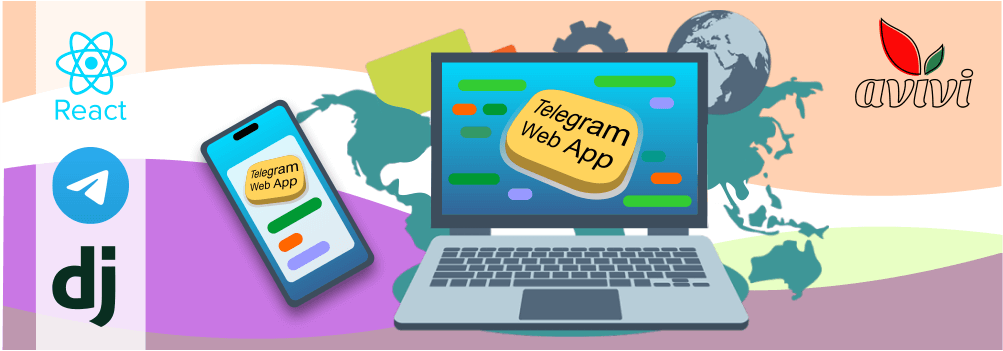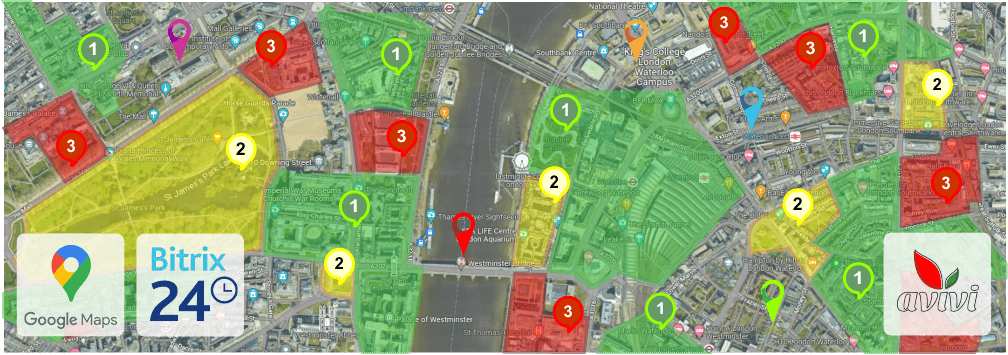We create our own Web App for Telegram bot
17 June 2024
next article
About the author: Bohdan Tomchishen , backend developer of Avivi with many years of experience in creating custom solutions for business. Developed bots of various levels of complexity, including cryptobots, sniper bots and other automated solutions for Telegram.
Telegram has long gone beyond the usual messenger, which it was at the beginning of its development, and constantly receives new useful features. In 2022, the Web tool appeared here App is a kind of add-on for working with chatbots. With its help, companies got the opportunity to improve their bots, make them more functional and attractive to users.
Today the Web App is used for any business, as it can be used to implement almost any IT development task:
-
Creating a product catalog for eCommerce;
-
Tools for managers;
-
Development of games with a full interface and much more.
Crypto wallet on the Web App
One of the tasks for the Avivi company was the development of a crypto wallet using TWA (Telegram Web App). The crypto wallet provides a convenient interface through which you can make a deposit to the created wallet, withdraw funds, create an exchange order, track the history of your transactions and orders, etc.

During the development, many tools are used, as well as different programming languages, both for the backend and for the frontend parts. ReactJS and Django are the main components on which this project is based. This pair provides a lot of opportunities for implementing projects of any complexity, has great flexibility and the ability to scale.
The backend part uses several different Python libraries, integration with exchange APIs that allow buying and selling of various coins. And also the basis of this is working with blockchains using their REST API, namely blockchain Tron, Ethereum, Bitcoin, Litcoin and Binance-smart-chain.
What does it look like in code?
Endpoint processing code for the main page:
1 2 3 4 5 6 7 8 9 10 11 12 13 14 15 16 17 18 19 20 21 22 23 24 25 26 27 28 29 30 31 32 33 34 35 36 37 38 39 40 41 42 43 44 45 46 47 48 49 50 51 52 53 54 55 56 57 58 59 60 61 62 63 |
class StartWebAppAPIView(generics.RetrieveAPIView): """ A `StartWebAppAPIView` class for retrieve information(such as total balance, balance by cryptocurrencies and transaction history) about a user and retrieve or create new balances. """ queryset = Profile.objects.all() serializer_class = ProfileSerializer lookup_field = "telegram_id" def get_object(self) -> Profile: """ Returns a `Profile object` or creates a new one if it does not exist. """ object_ = Profile.objects.filter(telegram_id=self.kwargs.get("telegram_id")) if object_.exists(): return object_.first() else: object_ = Profile.objects.create( telegram_id=self.kwargs.get("telegram_id"), first_name=self.request.data.get("message", {}).get("from", {}).get("first_name", "No name"), last_name=self.request.data.get("message", {}).get("from", {}).get("last_name", "No last name"), user_name=self.request.data.get("message", {}).get("from", {}).get("username", "No username"), client_language=self.request.data.get("message", {}).get("from", {}).get("client_language", "uk"), ) tokens = Token.objects.all().order_by("priority_level") for token in tokens: Balance.objects.create( profile=object_, token=token, network=token.network.first(), amount=0 ) return object_ def retrieve(self, request, *args, **kwargs) -> Response: """ Returns the user's serialized data, his total balance converted to USDT, balance by cryptocurrencies, and his transaction history. """ user: Profile = self.get_object() _user_balances: Balance = user.balance_set.all() serializer: ProfileSerializer = self.get_serializer(instance=user) total_user_balance: float = UserHelper.get_total_balance_in_usdt(user_balances=_user_balances) balances_by_cryptocurrencies: list[dict] = UserHelper.get_balances_by_cryptocurrencies( user_balances=_user_balances ) transactions_history: list[dict] = UserHelper.get_transaction_history(user=user) return Response( data={ "user": serializer.data, "user_balance": total_user_balance, "token_name": "USDT", "cryptocurrency": balances_by_cryptocurrencies, "transaction_history": transactions_history }, status=status.HTTP_200_OK ) |
And to the most interesting. This is how an example of working with the REST API of the blockchain looks like Ethereum:
1 2 3 4 5 6 7 8 9 10 11 12 13 14 15 16 17 18 19 20 21 22 23 24 25 26 27 28 29 30 31 32 33 34 35 36 37 38 39 40 41 42 43 44 45 46 47 48 49 50 51 52 53 54 55 56 |
class ETHStrategy(BlockchainStrategy): def __init__(self, network: str): self._blockchain = Blockchain.objects.get(symbol="ETH") self._network = Network.objects.get(blockchain=self._blockchain, network_type=network) self._network_type = network self._chain_id = self._network.chain_id self.web3 = Web3(Web3.HTTPProvider(endpoint_uri=self._network.url_rpc)) def create_wallet(self): new_account = self.web3.eth.account.create() return new_account.address, new_account.key.hex() def _create_tx(self, from_address: Address, to_address: Address, amount: Decimal) -> dict: tx = { 'from': from_address, 'to': to_address, 'gasPrice': self.web3.eth.gas_price, 'nonce': self.web3.eth.get_transaction_count(from_address), 'value': self.web3.to_wei(amount, 'ether'), 'chainId': self._chain_id, } gas = self.web3.eth.estimate_gas(tx) tx['gas'] = gas return tx def send_transaction(self, private_key: str, to_address: Address, amount: Decimal, contract_address: Address) -> str: account = Account.from_key(private_key) try: if contract_address is None: tx = self._create_tx(account.address, to_address, amount) else: token_helper = ERC20TokenHelper(smart_contract_address=contract_address, web3=self.web3) tx = token_helper.transfer(from_address=account.address, to_address=to_address, amount=amount) except ValueError as ex: if 'gas required exceeds allowance' in ex.args[0]['message']: raise TransactionGasPriceTooLow raise signed_tx = self.web3.eth.account.sign_transaction(tx, private_key) tasks.send_broadcast_callback.apply_async(kwargs={'signed_tx':signed_tx.hash, 'raw_tx':signed_tx.rawTransaction, 'wallet_address':account.address, 'network_type':self._network_type}, queue='sending_callback_tasks', routing_key='apps.api.tasks.sending_callback_tasks') return signed_tx.hash.hex() |
In conclusion, it is worth noting that the appearance of the Web The App significantly influenced the development of Telegram bots and opened wide possibilities for developers. And if earlier the interaction with the bot was limited to the standard functions of the Telegram interface, now the applications provide complete freedom of action. Therefore, you should not neglect such opportunities: contact Avivi for the development of your own Telegram bot, and our team will bring any idea you have to life.
We will reach out to within 10 minutes



